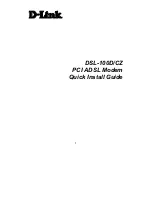
7
BUSY
Busy signal detected.
8
NOANSWER Five seconds of silence not detected after ring
back when @ dial modifier is used.
12.4 Basic AT Parameters
These commands control the basic configuration of the modem. The parameters can only
be read back by the
AT&V
† command when in command state. The following table
shows the command format.
Basic AT Parameters Table
Parameter
Description
E0
Do not echo commands in command state or in online state
E1
Echo commands in command state or in online state
Q0
Return result codes
Q1
Do not return result codes
V0
Display result codes as numbers.
V1
Display result codes as words.
X1
Enable additional result code CONNECT <rate>. Disable
dial tone and busy detection.**
X2
Enable additional result codes CONNECT <rate> and NO
DIALTONE. Disable busy detection. Enable dial-tone
detection.**
X3
Enable additional result codes CONNECT <rate> and
BUSY. Enable busy detection. Disable dial-tone
detection.**
X4
Enable additional result codes CONNECT <rate>, BUSY
and NO DIALTONE. Enable busy and dial-tone
detection.**
Z0
Reset to default configuration
&F0
Effect is implementation dependent. Same behavior as Z.
&V
Dump configuration parameters
*For async data/fax settings, the dialtone detection settings do not apply.
**Factory default settings.
12.5 Extended Commands
The extended commands use the extended syntax. To set a value using an extended
command, use the WRITE command:
AT+CMD=
xxx
where CMD is the command and
xxx
is the value. Some extended commands take more
than one value. For example, the Write command for two values becomes:
AT+CMD=
xxx,yyy
Some extended commands take characters strings as values, instead of numbers. In that
case, the syntax is:
AT+CMD=
"
CharacterString
"
Note that while spaces are ignored everywhere else, spaces are significant inside the
quotation marks. To read back a value, use the READ command:
AT+CMD?
To test if a particular command is supported, along with the range of values it supports,
use the TEST command:
AT+CMD=?














































